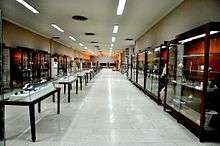Sulaymaniyah Museum
The Sulaymaniayh Museum (Kurdish: مۆزهخانهی سلێمانی; Arabic: متحف السليمانية) is an archeological museum which is located within heart of the city of Sulaymaniyah, Sulaymaniyah Governorate, Kurdistan Region, Iraq. It is also known as Slemani Museum or Sulaimaniya Museum.It is the second largest museum in Iraq, after the National Museum of Iraq in Baghdad in terms of contents. It houses artifacts which date back to the pre-historic period to the late Islamic and Ottoman periods.
History
Opening

The Museum was opened officially on July 14, 1961. Initially, it was composed of a small building in the Shorsh District. After several years, the Museum acquired a new and a large building in the heart of Salim Street in the year 1980 CE. The current building has an area of 6000 square meter and is a one-story building. The artifacts are displayed in one small hall (which was recently renovated by the UNESCO) and two large and long halls which are connected by a squared-shaped and open lecture hall. During the Iraq-Iran era (1980-1988 CE), the Museum was closed entirely to the public. It was reopened for a very short period in 1990 CE. After the Iraqi invasion of Kuwait in August 1990 CE, the Museum was closed once again. It was re-opened officially by Mr. Jalal Talabani in August 20, 2000 CE; Mr. Talabani was the secretory general of the Patriotic Union of Kurdistan at that time.[1]
Post-2003
After the US-lead invasion of Iraq and subsequent looting of the Iraqi Museum in Baghdad, The Sulaymaniyah Museum helped to recover and return stolen artifacts through the controversial practice of buying looted artifacts.[2]
UNESCO

Since 2011 CE, the Museum has been collaborating with the UNESCO to develop and renovate the Museum and expand its building.[3]
References
- ↑ "History, Slemani museum". www.slemanimuseum.org. Retrieved 16 January 2015.
- ↑ "Slemani Museum tires to return stolen artifacts". www.kurdsat.tv. Kurdsat Television. Retrieved 16 January 2015.
- ↑ "The Museum, Slemani Museum". www.slemanimuseum.org. Retrieved 16 January 2015.
- http://www.unesco.org/new/en/iraq-office/culture/museum-sector/sulaymaniyah-museum/
- http://www.unesco.org/new/en/iraq-office/about-this-office/single-view/news/sulaymaniyah_museum_opens_its_first_renovated_halls_to_public/#.VLlfLicVlRk
- http://www.iraq-businessnews.com/?s=sulaymaniyah
Coordinates: 35°33′27.25″N 45°25′32.95″E / 35.5575694°N 45.4258194°E